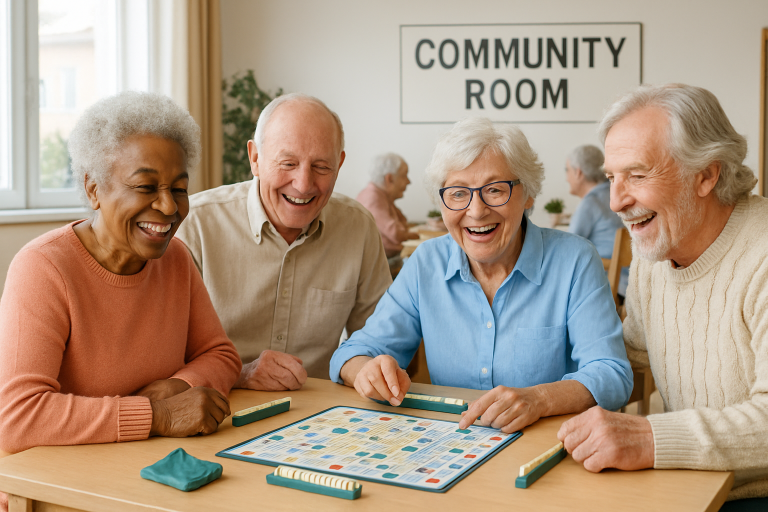Table of Contents
- Enhanced Social Connections
- Improved Physical Health
- Mental and Emotional Well-being
- Safety and Security
- Access to Healthcare Services
- Opportunities for Lifelong Learning
- Reduced Responsibilities
- Diverse Living Options
As the years progress, making choices about living arrangements becomes one of the most significant decisions for older adults and their families. Opting for community living isn’t just about securing a place to stay—it’s about finding a setting that enriches daily life, encourages independence, and creates a sense of belonging. Those exploring retirement communities in Sussex County will find that these environments offer seniors a host of unique benefits beyond just safety, including enhanced social engagement, assistance with daily tasks, and comprehensive wellness programs.
Today’s senior living communities are designed to support an engaging and active lifestyle. With modern amenities, social activities, and tailored services, these communities deliver a comprehensive solution for seniors aiming to maintain their health, happiness, and autonomy. By making the move, many discover new friendships, improved health, and continued opportunities for personal fulfillment.
Community living models also ease the transition to older adulthood by alleviating common stressors, such as home maintenance or the risk of isolation. Families often find peace of mind knowing that their loved ones live in secure settings with quick access to help, healthcare, and social programs.
Enhanced Social Connections
Isolation can be detrimental to the mental and physical well-being of seniors. One of the most celebrated benefits of community living is the ability to form and maintain social connections. Scheduled programs—like game nights, fitness groups, or outings to local attractions—promote regular interaction with peers. In fact, studies have shown that engaging with others in meaningful ways helps reduce the risk of depression, cognitive decline, and even chronic illnesses.
Some innovative communities even partner with nearby restaurants and cafes to offer group meals, creating comfortable, social environments and making dining a communal experience. These types of programs not only nourish physically but also provide a structured way to build a new support network as life circumstances change.
Improved Physical Health
Ongoing physical activity is a critical element of healthy aging. Senior living communities recognize this by offering tailored exercise classes, walking trails, and access to group sports or yoga sessions. Regular physical activity can help improve mobility, reduce the risk of falls, and manage conditions such as arthritis or heart disease. Furthermore, having fitness activities available on-site lowers the barriers to participation, encouraging residents to stay active throughout the year.
Mental and Emotional Well-being
Community living provides a supportive backdrop where seniors can thrive emotionally. The sense of camaraderie contributes to higher self-esteem, while daily routines and scheduled events prevent feelings of aimlessness. Many communities integrate creative outlets—like art classes, gardening, or discussion groups—that serve as both therapeutic and stimulating. According to the American Psychological Association, such programs have a significant impact on cognitive resiliency and emotional stability.
Safety and Security
Security features are a fundamental advantage in senior living environments. Gated entries, emergency call systems, staff trained in first aid, and 24/7 on-site support ensure quick help when it’s needed most. This added layer of protection offers both residents and families peace of mind, allowing seniors to embrace independence with confidence while knowing they are never far from assistance.
Access to Healthcare Services
Immediate access to healthcare significantly enhances the quality of life for older adults, particularly those managing chronic conditions. Many communities have nursing staff, on-site medical care, or established relationships with local healthcare providers. Regular check-ups, assistance with medication management, and support with activities of daily living (ADLs) ensure that residents can age in place safely and comfortably.
Opportunities for Lifelong Learning
Lifelong learning is emphasized in modern senior communities through a variety of courses, lectures, and hands-on workshops. Residents may take up new hobbies, learn digital skills, or participate in reading groups led by local educators. These experiences not only sharpen cognitive skills but also enrich daily life, making retirement a personally rewarding experience.
Reduced Responsibilities
One underappreciated benefit is the newfound freedom from chores and household maintenance. Communities typically take care of all home repairs, landscaping, housekeeping, and even offer organized transportation. This allows seniors to focus their energy on meaningful pursuits, rest, and time with loved ones, resulting in lower stress levels and improved well-being.
Diverse Living Options
Senior living communities are designed to cater to a range of needs and preferences. Options may include independent living for those seeking a vibrant, low-maintenance lifestyle, assisted living for individuals requiring some daily support, and specialized memory care for residents with Alzheimer’s or dementia. The flexibility in care levels allows residents to often remain in their chosen community, even as their needs change over time.
In summary, community living offers seniors a unique opportunity to maintain independence while accessing comprehensive support, social connections, and enriching experiences. By considering retirement communities, seniors can enjoy a secure and stimulating environment that truly supports their ongoing health and well-being.






